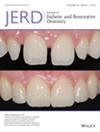Surface Roughness on Cementoenamel Junction After Rubber-Dam Clamp Application
Abstract
Objective
To investigate the surface roughness on cementoenamel junction after application of various rubber-dam retraction clamps for different durations.
Materials and Methods
Fifty-four extracted human molar teeth were used. Various retraction clamps were placed on the cementoenamel junction. There are three main examination groups in the study. Group 1 (n = 6) included a polymer clamp (SoftClamp, Kerr Hawe, Switzerland), Group 2 (n = 6) included a metal clamp with a flat edge (Black Line RDCM7X, Hu-Friedy Group, USA), and Group 3 (n = 6) included a metal clamp with a serrated edge (Fiesta Color Coded, Coltene, USA). All clamps were applied for 30 min, 1, and 2 h. Surface roughness measurements were performed using a profilometer before and after the clamp application and surface morphology was assessed through the SEM images. One-way ANOVA was used to compare three or more groups. Percentage changes were evaluated using the Kruskal–Wallis test, followed by Dunn's test for post hoc analyses. The deemed significance was set at p < 0.05.
Results
Between the initial and the final roughness measurements, after 30 min of clamp application, only Group 3 showed significant increases in roughness (p = 0.001). After 1 and 2 h of clamp application, there were significant increases in roughness for all groups. No significant differences in percentage changes for all groups in 30 min and 2 h of application (p = 0.220 and p = 0.091, respectively). However, Group 1 presented significantly lower surface roughness in percentage after the 1 h of application (p = 0.040). No significant differences in the percentage changes in roughness were observed within the groups for 30 min, 1, and 2 h applications (p = 0.220, p = 0.884, and p = 0.755 for Groups 1, 2, and 3, respectively). In SEM analysis, deep point microstructure defects were seen as the clamp application time increased.
Conclusions
Rubber-dam clamp application may cause damage to the cementoenamel junction area. However, the level of damage is clamp-type-dependent. Slight scratch-type damages were observed on teeth with plastic clamps, while metal clamps generally caused cracks. The increase in the duration of the same rubber-dam clamp application was not considered an effective factor regarding the damage.
Clinical Significance
During rubber-dam isolation, clamp type and duration of the application may cause damage to the tooth surface or progress an existing defect. Examining the teeth before selecting the clamp might be beneficial for minimizing dental tissue damage.

 求助内容:
求助内容: 应助结果提醒方式:
应助结果提醒方式:


